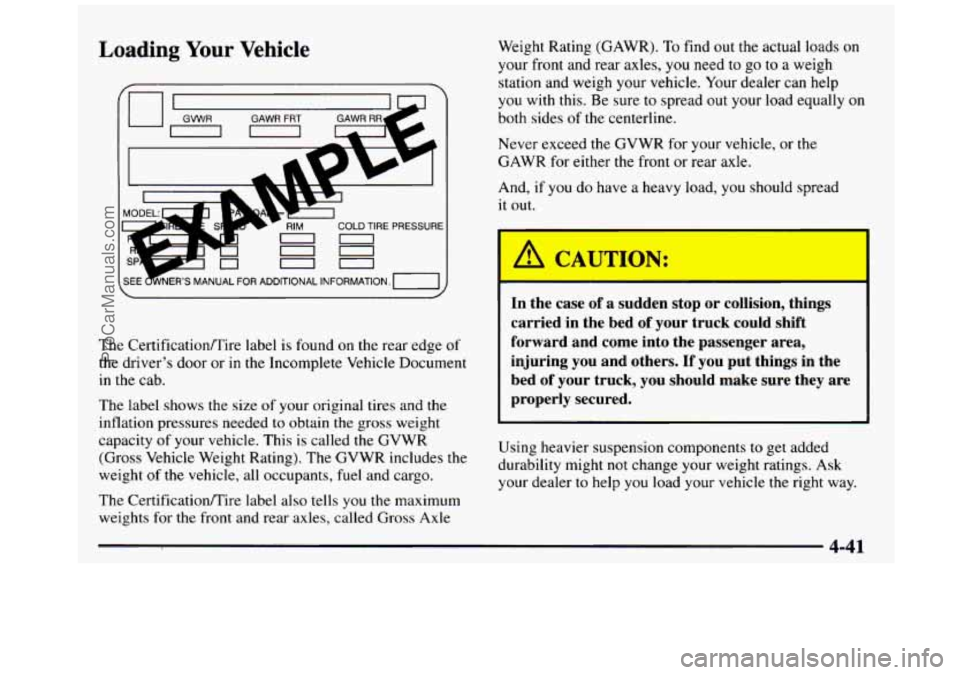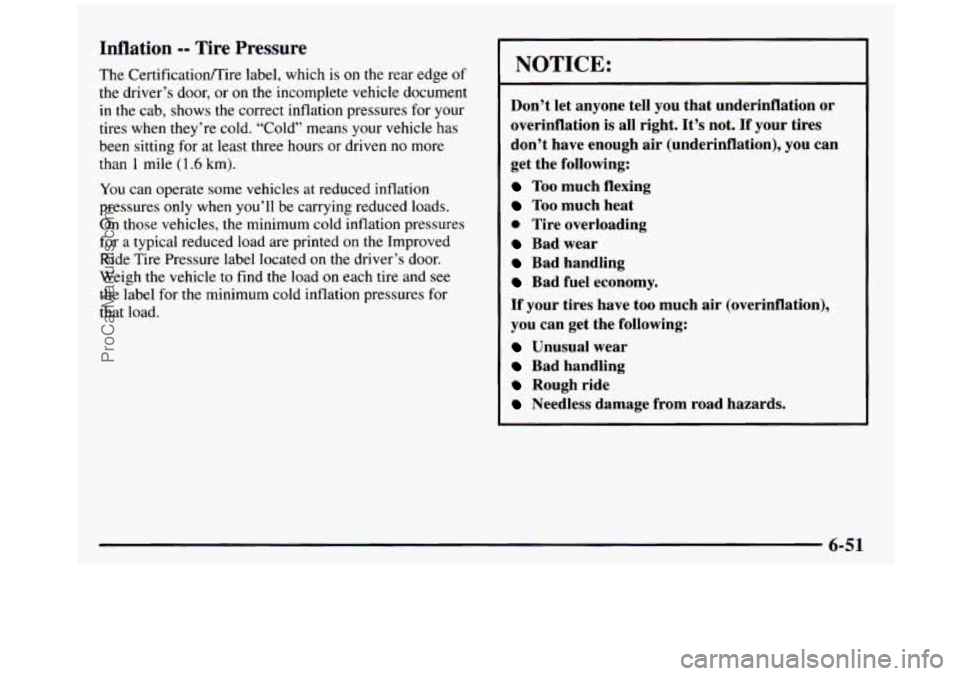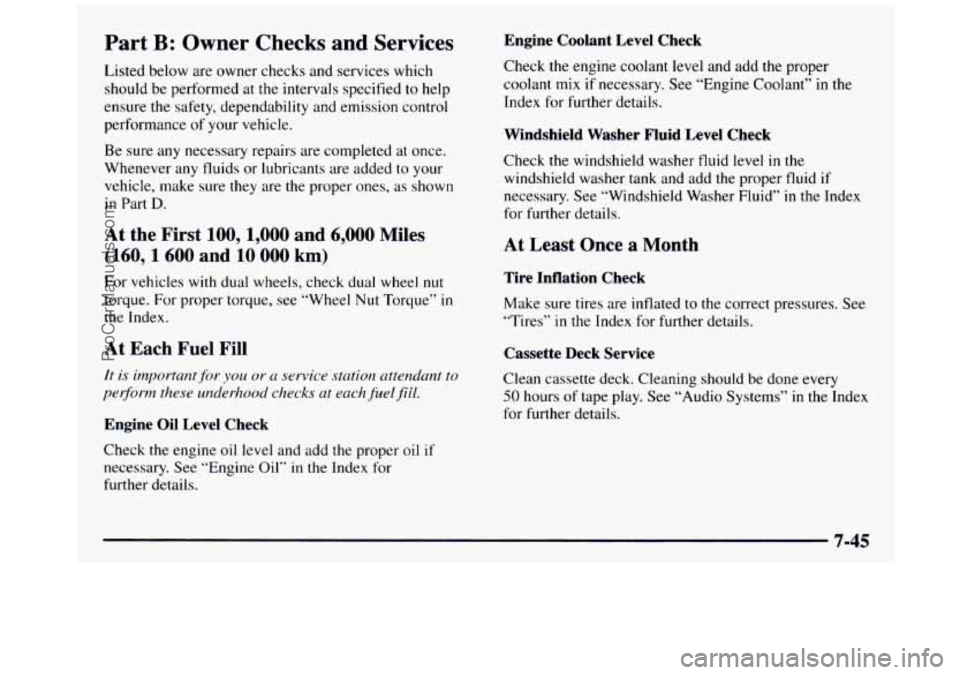Page 219 of 436

Loading Your Vehicle
I-
GAWR FRT
RIM COLD TIRE PRESSURE
-!=2 - I
The Certificationrnire label is found on the rear edge of
the driver’s door or in the Incomplete Vehicle Document
in the cab.
The label shows the size of
your original tires and the
inflation pressures needed to obtain the gross weight
capacity
of your vehicle. This is called the GVWR
(Gross Vehicle Weight Rating). The GVWR includes the
weight
of the vehicle, all occupants, fuel and cargo.
The Certificationmire label also tells you the maximum
weights for the front and rear axles, called Gross Axle Weight Rating (GAWR). To find out the actual loads on
your front and rear axles, you need
to go to a weigh
station
and weigh your vehicle. Your dealer can help
you
with this. Be sure to spread out your load equally on
both sides of the centerline.
Never exceed the
GVWR for your vehicle, or the
GAWR for
either the front or rear axle.
And, if you do have a heavy load, you should spread
it out.
/;1 CAUTION:
In the case of a den stop or collision, things
carried in the bed of your truck could shift
forward and come into the passenger area,
injuring you and others. If you put things in the
bed
of your truck, you should make sure they are
properly secured.
Using heavier suspension components to get added
durability might not change your weight ratings. Ask
your dealer to help you load
your vehicle the right way.
4-41
ProCarManuals.com
Page 327 of 436

Inflation -- Tire Pressure
The Certificationmire label, which is on the rear edge of
the driver’s door, or on the incomplete vehicle document
in the cab, shows the correct inflation pressures for your
tires when they’re cold. “Cold” means your vehicle has
been sitting for at least three hours or driven no more
than
1 mile (1.6 km).
You can operate some vehicles at reduced inflation
pressures only when you’ll be carrying reduced loads.
On those vehicles, the minimum cold inflation pressures
for
a typical reduced load are printed on the Improved
Ride Tire Pressure label located on the driver’s door.
Weigh the vehicle to find the load on each tire and see
the label for the minimum cold inflation pressures for
that load.
NOTICE:
Don’t let anyone tell you that underinflation or
overinflation is all right.
It’s not. If your tires
don’t have enough air (underinflation), you can
get the following:
Too much flexing
Too much heat
0 Tire overloading
Bad wear
Bad handling
Bad fuel economy.
If your tires have too much air (overinflation),
you can get the following:
Unusual wear
Bad handling
Rough ride
Needless damage from road hazards.
6-51
-
ProCarManuals.com
Page 329 of 436
111
V
n
111
If your vehicle has dual rear
wheels and the load range
or tread design for your
front tires is different from
your rear tires, always use
the correct rotation pattern
shown here
when rotating
your tires.
If your vehicle has dual rear wheels and the load range
and tread design for your front tires is the same as your
rear tires, always use one of the correct rotation patterns
shown here when rotating your tires. The dual tires are rotated as
a pair, and the inside rear
tires become the outside rear tires.
When you install dual wheels, be sure the vent holes
in
the inner and outer wheels on each side are lined up.
After the tires have been rotated,
adjust the front and
rear inflation pressures as shown on the
Certificatiomire label. Make certain that all wheel nuts
are properly tightened. See “Wheel Nut Torque” in
the Index.
ProCarManuals.com
Page 399 of 436

Part B: Owner Checks and Services
Listed below are owner checks and services which
should be performed at the intervals specified
to help
ensure the safety, dependability and emission control
performance
of your vehicle.
Be sure any necessary repairs are completed at once.
Whenever any fluids or lubricants are added
to your
vehicle, make sure they are the proper ones,
as shown
in Part
D.
At the First 100, 1,000 and 6,000 Miles
(160,1600 and 10 000 km)
For vehicles with dual wheels, check dual wheel nut
torque. For proper torque, see “Wheel Nut Torque” in
the Index.
At Each Fuel Fill
It is important for you or ~1 service station attendant to
per$orm these underhood
checks ut eachjbtelfiE1.
Engine Oil Level Check Engine Coolant Level Check
Check the
engine coolant level and add the proper
coolant mix if necessary. See “Engine Coolant’’ in the
Index for further details.
Windshield Washer Fluid Level Check
Check the windshield washer fluid level in the
windshield washer tank and add
the proper fluid if
necessary. See “Windshield Washer Fluid”
in the Index
for further details.
At Least Once a Month
Tire Inflation Check
Make sure tires are inflated to the correct pressures. See
“Tires”
in the Index for further details.
Cassette Deck Service
Clean cassette deck. Cleaning should be done every
50 hours of tape play. See “Audio Systems” in the Index
for further details.
Check
the engine oil level and add the proper oil if
necessary. See “Engine Oil” in the Index for
further details.
7-45
ProCarManuals.com